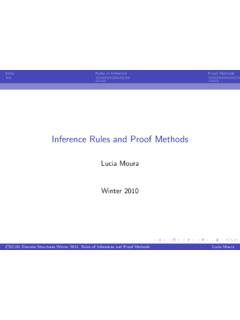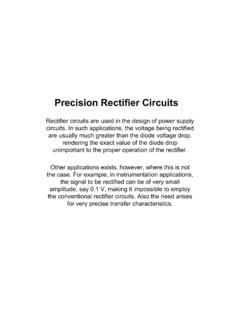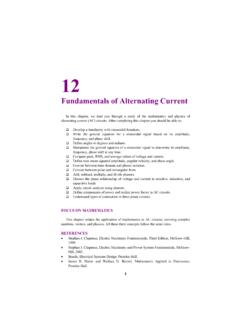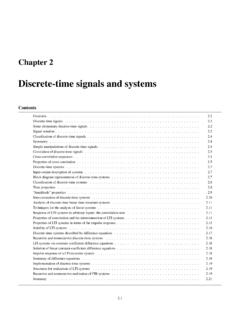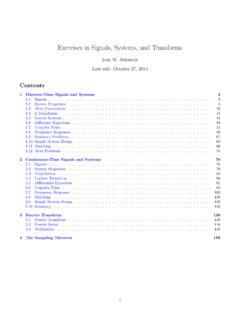Transcription of Chapter 3 Fourier Series Representation of Period Signals
1 ELG 3120 Signals and Systems Chapter 3 1/3 Yao Chapter 3 Fourier Series Representation of Period Signals Introduction Signals can be represented using complex exponentials continuous-time and discrete-time Fourier Series and transform. If the input to an LTI system is expressed as a linear combination of periodic complex exponentials or sinusoids, the output can also be expressed in this form. A Historical Perspective By 1807, Fourier had completed a work that Series of harmonically related sinusoids were useful in representing temperature distribution of a body. He claimed that any periodic signal could be represented by such Series Fourier Series .
2 He also obtained a Representation for aperidic Signals as weighted integrals of sinusoids Fourier Transform. Jean Baptiste Joseph Fourier The Response of lti systems to Complex Exponentials It is advantageous in the study of lti systems to represent Signals as linear combinations of basic Signals that possess the following two properties: The set of basic Signals can be used to construct a broad and useful class of Signals . ELG 3120 Signals and Systems Chapter 3 2/3 Yao The response of an LTI system to each signal should be simple enough in structure to provide us with a convenient Representation for the response of the system to any signal constructed as a linear combination of the basic signal .
3 Both of these properties are provided by Fourier analysis. The importance of complex exponentials in the study of LTI system is that the response of an LTI system to a complex exponential input is the same complex exponential with only a change in amplitude; that is Continuous time: ststesHe)( , ( ) Discrete-time: nnzzHz)( , ( ) where the complex amplitude factor )(sH or )(zH will be in general be a function of the complex variable s or z. A signal for which the system output is a (possible complex) constant times the input is referred to as an eigenfunction of the system , and the amplitude factor is referred to as the system s eigenvalue.
4 Complex exponentials are eigenfunctions. For an input )(tx applied to an LTI system with impulse response of )(th, the output is dehedehdehdtxhtyssttsts + + + + === =)()()()()()()()(, ( ) where we assume that the integral dehs + )( converges and is expressed as dehsHs + =)()(, ( ) the response to ste is of the form stesHty)()(=, ( ) It is shown the complex exponentials are eigenfunctions of lti systems and )(sH for a specific value of s is then the eigenvalues associated with the eigenfunctions. Complex exponential sequences are eigenfunctions of discrete-time lti systems . That is, suppose that an LTI system with impulse response ][nh has as its input sequence ELG 3120 Signals and Systems Chapter 3 3/3 Yao nznx=][, ( ) where z is a complex number.
5 Then the output of the system can be determined from the convolution sum as = = === =kknkknkzkhzzkhknxkhny][][][][][. ( ) Assuming that the summation on the right-hand side of Eq. ( ) converges, the output is the same complex exponential multiplied by a constant that depends on the value of z. That is, nzzHny)(][=, ( ) where = =kkzkhzH][)(. ( ) It is shown the complex exponentials are eigenfunctions of lti systems and )(zH for a specific value of z is then the eigenvalues associated with the eigenfunctions nz. The example here shows the usefulness of decomposing general Signals in terms of eigenfunctions for LTI system analysis.
6 Let tststseaeaeatx321321)(++=, ( ) from the eigenfunction property, the response to each separately is tstsesHaea11)(1111 tstsesHaea22)(2222 tstsesHaea33)(3333 and from the superposition property the response to the sum is the sum of the responses, tststsesHaesHaesHaty321)()()()(333222111 ++=, ( ) Generally, if the input is a linear combination of complex exponentials, =ktskkeatx)(, ( ) the output will be ELG 3120 Signals and Systems Chapter 3 4/3 Yao =ktskkkesHaty)()(, ( ) Similarly for discrete-time lti systems , if the input is =knkkzanx][, ( ) the output is =knkkkzzHany)(][, ( ) Fourier Series Representation of Continuous-Time Periodic Signals Linear Combinations of harmonically Related Complex Exponentials A periodic signal with Period of T, )()(Ttxtx+= for all t, ( ) We introduced two basic periodic Signals in Chapter 1, the sinusoidal signal ttx0cos)( =, ( ) and the periodic complex exponential tjetx0)( =, ( ) Both these Signals are periodic with fundamental frequency 0 and fundamental Period 0/2 =T.
7 Associated with the signal in Eq. ( ) is the set of harmonically related complex exponentials tTjktjkkeet)/2(0)( ==, ..,2,1,0 =k ( ) Each of these Signals is periodic with Period of T(although for 2 k, the fundamental Period of )(tk is a fraction of T). Thus, a linear combination of harmonically related complex exponentials of the form ELG 3120 Signals and Systems Chapter 3 5/3 Yao + =+ ===ktTjkkktjkkeaeatx)/2(0)( , ( ) is also periodic with Period of T. 0=k, )(tx is a constant. 1+=k and 1 =k, both have fundamental frequency equal to 0 and are collectively referred to as the fundamental components or the first harmonic components.
8 2+=k and 2 =k, the components are referred to as the second harmonic components. Nk+=and Nk =, the components are referred to as the Nth harmonic components. Eq. ( ) can also be expressed as + = ==ktjkkeatxtx0*)(*)( , ( ) where we assume that )(tx is real, that is, )(*)(txtx=. Replacing k by k in the summation, we have + = =ktjkkeatx0*)( , ( ) which , by comparison with Eq. ( ), requires that kkaa =*, or equivalently kkaa =*. ( ) To derive the alternative forms of the Fourier Series , we rewrite the summation in Eq. ( ) as [] + = ++=1)/2(00)(ktTjkktjkkeaeaatx . ( ) Substituting ka* for ka , we have [] + = ++=1)/2(0*)(0ktTjkktjkkeaeaatx.
9 ( ) Since the two terms inside the summation are complex conjugate of each other, this can be expressed as {} + =+=100Re2)(ktjkkeaatx . ( ) ELG 3120 Signals and Systems Chapter 3 6/3 Yao If ka is expressed in polar from as kjkkeAa =, then Eq. ( ) becomes {} + =++=1)(00Re2)(ktkjkkeAatx . That is + =++=100)cos(2)(kkktkAatx . ( ) It is one commonly encountered form for the Fourier Series of real periodic Signals in continuous time. Another form is obtained by writing ka in rectangular form as kkkjCBa+= then Eq. ( ) becomes [] + = +=1000sincos2)(kkktkCtkBatx . ( ) For real periodic functions, the Fourier Series in terms of complex exponential has the following three equivalent forms.
10 + =+ ===ktTjkkktjkkeaeatx)/2(0)( + =++=100)cos(2)(kkktkAatx [] + = +=1000sincos2)(kkktkCtkBatx ELG 3120 Signals and Systems Chapter 3 7/3 Yao Determination of the Fourier Series Representation of a Continuous-Time Periodic signal Multiply both side of + ==ktjkkeatx0)( by tjne0 , we obtain + = =ktjntjkktjneeaetx000)( , ( ) Integrating both sides from 0 to 0/2 =T, we have + = + = = =kTtnkjkkTtjntjkkTtjndteadteeadtetx0)(00 0000)( , ( ) Note that == nknkTdteTtnkj,0,0)(0 So Eq. ( ) becomes dtetxTaTtjnn =00)(1 , ( ) The Fourier Series of a periodic continuous-time signal + =+ ===ktTjkkktjkkeaeatx)/2(0)( ( ) dtetxTdtetxTaTtTjkTtjkk ==)/2()(1)(10 ( ) Eq.


